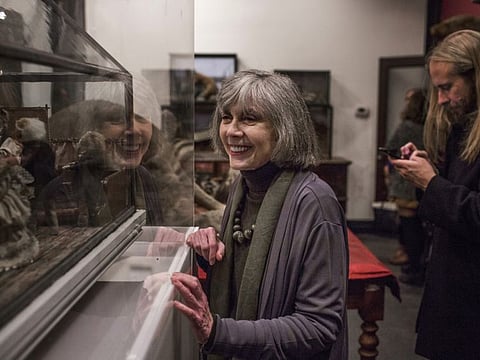Anne Rice, writer who spun gothic tales, dies at 80
Her son wrote on social media that the cause was complications from a stroke

Anne Rice, the gothic novelist best known for ‘Interview With the Vampire’, the 1976 book that in 1994 became a popular film starring Tom Cruise and Brad Pitt, died Saturday. She was 80.
Her son, Christopher Rice, wrote on social media that the cause was complications from a stroke. His post did not say where she died.
Anne Rice was a largely unknown writer when she turned a short story she had written in the late 1960s into ‘Interview With the Vampire,’ her first published novel. It features a solitary vampire named Louis who is telling his life story to a reporter, but Rice said the tale was her story as well.
“I really got into the character,” she told The New York Times in 1986. “For the first time, I was able to describe my reality, the dark, gothic influence on my childhood. It’s not fantasy for me. My childhood came to life for me.”
Many critics gave the book short shrift, seeming not to grasp either its tone or its appeal.
“The publicity tells us Rice is ‘a dazzling storyteller,’” Leo Braudy wrote in The Times. “But there is no story here, only a series of sometimes effective but always essentially static tableaus out of Roger Corman films, and some self-conscious soliloquising out of Spiderman comics, all wrapped in a ballooning, pompous language.”
The reading public, though, latched on; ‘Interview With the Vampire’ became a bestseller, and Rice found herself with a considerable fan base, which she proceeded to entertain with a series of follow-up novels that became known collectively as the Vampire Chronicles. The books, more than a dozen in all, are widely credited with fuelling a revival of interest in all things vampiric, which has been reflected on the big and small screens as well as onstage ever since.
But Rice, who wrote dozens of books in all, was not a one-subject novelist. She wrote free-standing novels like ‘Cry to Heaven’ (1982), about the careers of two castrati. Under the name Anne Rampling, she wrote steamy novels including ‘Exit to Eden’ (1985). And as AN Roquelaure, she wrote an erotic series known as the ‘Sleeping Beauty’ novels.
Rice’s fans are nothing if not passionate, willing to immerse themselves in the worlds she created.
“When I go to my signings,” she told ABC News programme ‘Day One’ in 1993, “I’m the most boring person there. Everybody else is dripping with velvet and lace, and bringing me dead roses wrapped in leather handcuffs, and I love it.”
Her books resonated not only with fans of gothic romance but also with readers who found a spiritual element in them, some LGBTQ readers who identified with their themes of isolation and alienation, and other groups. Critics may have sometimes been dismissive of her writing, but she aspired to more.
“What matters to me is that people know that my books are serious and that they are meant to make a difference and that they are meant to be literature,” she told The Times in 1990. “Whether that’s stupid or pretentious-sounding, I don’t care. They are meant to be in those backpacks on the Berkeley campus, along with Castaneda and Tolstoy and anybody else. When I get dismissed as a ‘pop’ writer I go crazy.”
Howard Allen O’Brien was born October 4, 1941, in New Orleans to Howard and Katherine O’Brien. (Oddly, she had been named after her father; by the time she was in first grade she had adopted “Anne.”) Her father worked for the postal service, and her mother was a homemaker.
She grew up in New Orleans, writing plays that she and her three sisters would perform and imagining ghostly figures in the windows of the New Orleans mansions she would stroll past. Movies like “Dracula’s Daughter” (1936) made a vivid impression.
So did her Roman Catholic upbringing and education, full of imagery that played to her already vivid imagination.
“To sit and listen to the miracles that happened to this saint or that saint, or how somebody floated up in the air during prayer, I mean, that was just the normal fare in Catholic school,” she said.
When she was 15 her mother died; she said she believed the cause was alcoholism, something that Rice would struggle with later, although in a 2008 video she said she had been sober for 28 years.
Sign up for the Daily Briefing
Get the latest news and updates straight to your inbox


